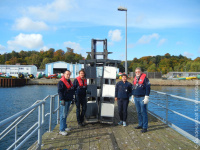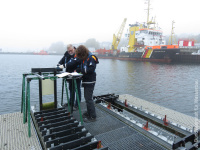Corrosion protection tests (steel structures and corrosion protection)
From BAWiki

The wide range of stresses to which coatings of hydraulic steel structures are exposed calls for an appropriate testing programme to provide qualitative evidence of their suitability. Besides standardised corrosion protection tests (e.g. resistance to neutral salt spray), additional test procedures to address the WSV’s specific requirements (e.g. condensate water changing test and abrasion test as well as a cathodic protection compatibility test) are also employed.

Ultimately, the coating systems tested in the lab have to reproduce the evidence of their suitability in a natural environment. The BAW has four exposure locations that it can use for this purpose, two river sites in Trier and Windheim and two coastal sites in Kiel and Büsum. The protective properties of all coating systems are studied at these sites over a five-year period in various stress zones in order to guarantee that any coating systems that have been optimised based on laboratory tests have their strengths and weaknesses investigated thoroughly.
As well as qualitative tests of corrosion protection coatings run on behalf of the WSV, aspects such as specific corrosion scenarios (microbial corrosion (MIC) or bimetallic corrosion), an ecotoxicological analysis of the coating materials used and/or cost-effective alternative repair methods ("smart repair") are also studied.
-
Picture 3: Rust creep test at the scribe of a sample from long-term exposure
-
Picture 4: BAW test to determine the suitability of coatings for cathodic protection (CP)
-
Picture 5: Coating samples undergoing a salt spray test
-
Picture 6: Coating thickness measurement and pull-offs on tested coatings
-
Picture 7: Measuring the potential distribution of a CP-protected canal bridge
-
Picture 8: Colour measurement on a lock gate
back to: Structural Engineering Methods






